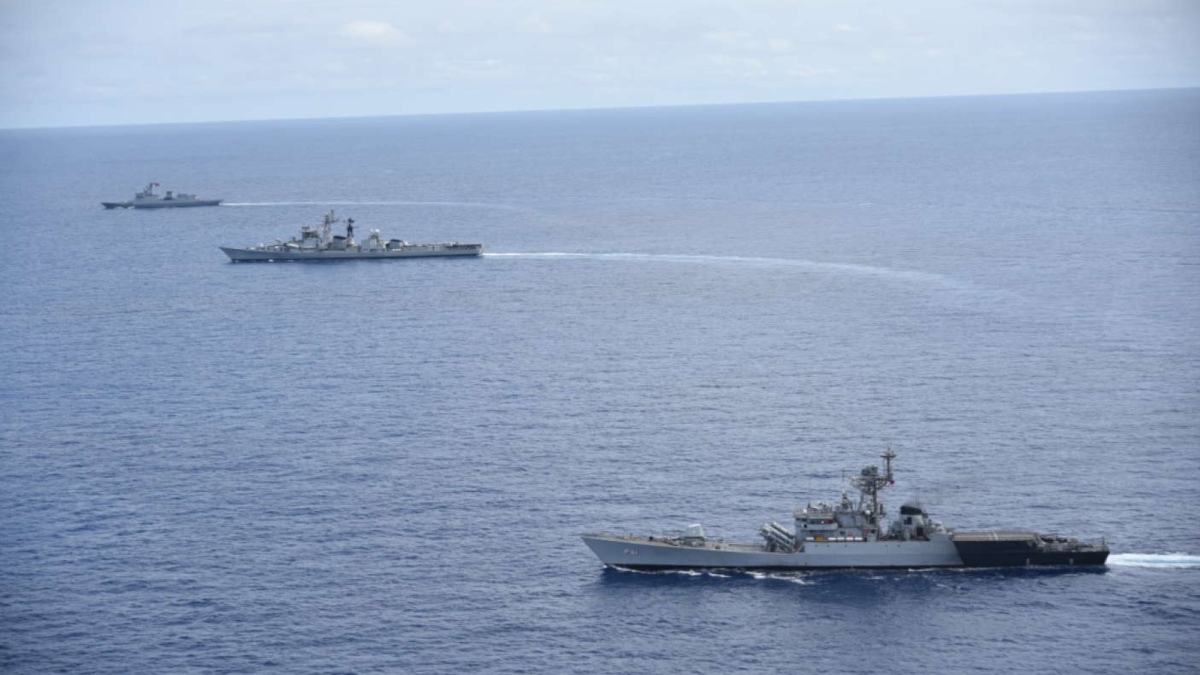Two ships of the Indian Navy, namely INS Ranvijay (Guided Missile Destroyer, D55) and INS Kora (Guided Missile Corvette, P61), on deployment to the Western Pacific, carried out a maritime partnership exercise with BRP Antonio Luna (Frigate, FF 151) of the Philippine Navy on Monday in the West Philippine Sea. The joint evolutions conducted during the exercise included several operational manoeuvers and the participating ships of both navies were satisfied with the consolidation of interoperability achieved through this operational interaction at sea.



The Indian naval ships are currently deployed to the Western Pacific to strengthen maritime security collaboration with partner nations. The interaction with BRP Antonio Luna was, therefore, an enriching opportunity for the Indian Navy to consolidate its bilateral relations with the Philippine Navy. In compliance with the prevailing pandemic guidelines, the exercise was conducted in a contactless manner and all necessary health and safety protocols were strictly observed. After the exercise, the Indian naval ships are scheduled to call at Manila Port for replenishment. India and The Philippines share a very robust defence and security partnership built over several years and spanning across all domains. Both navies remain committed to further strengthening bilateral collaboration in the maritime domain towards a collective aim of ensuring a stable, peaceful and prosperous Indo-Pacific.
EXERCISE KONKAN 2021
Exercise Konkan 2021 was held between INS Tabar and HMS Westminster on 16 August on the English Channel. The exercise included the participation of integral helicopters of the two ships and the Falcon Electronic Warfare aircraft. A wide range of exercises including coordinated anti-submarine procedures, firing drills, combined maritime picture compilation, combat formation manoeuvring and replenishment at sea were conducted. These along with the diverse professional engagements held earlier in the harbour have enabled Exercise Konkan 2021 to consolidate interoperability and helped cement the strong bonds of friendship between the two navies.
JOINT GUIDANCE FOR AUSTRALIA AND INDIA NAVIES
A ‘Joint Guidance for the Australia-India Navy to Navy Relationship’ document was signed between the Indian Navy and Royal Australian Navy on 18th August. The signing ceremony was held virtually between Adm Karambir Singh, Chief of the Naval Staff, Indian Navy and Vice Admiral Michael J Noonan, Chief of Navy, Australian Navy. The document is aligned to the ‘2020 Comprehensive Strategic Partnership’ agreed by the Prime Ministers and aims to ensure a shared approach to regional and global security challenges. The Joint Guidance would serve as a guideline document to showcase the intent of both the Navies to work together bi/multi-laterally. The broad scope of the guidance is focused on developing mutual understanding, cooperate for regional security, collaborate in mutually beneficial activities and developing interoperability.
The highlights of the document include close cooperation in regional and multilateral fora, including the Indian Ocean Naval Symposium (IONS), Western Pacific Naval Symposium (WPNS), Indian Ocean Rim Association (IORA)and Expert Working Groups subordinate to the ASEAN Defence Ministers’ Meeting Plus framework. Bilateral defence relations between India and Australia have strengthened over the years. ‘Comprehensive Strategic Partnership’, Mutual Logistics Support Agreement, the conduct of trilateral Maritime Security Workshop and RAN participation in Exercise MALABAR are significant milestones that underline the role played by both Navies in bolstering this relationship in recent times. The document would be pivotal in consolidating the shared commitment to promote peace, security, stability and prosperity in the Indo – Pacific region.
TWO INDIAN NAVY SHIPS TO PARTICIPLE IN MULTILATERAL EX MALABAR
Indian Naval Ships Shivalik and Kadmatt arrived at Guam, an Island Territory of the US as part of their ongoing deployment to nations in South East Asia and the Pacific Ocean. The two ships are scheduled to participate in the annual Exercise MALABAR-21, between navies of Australia, India, Japan and the US. MALABAR series of maritime exercises commenced in 1992 as a bilateral IN-USN exercise and has grown in stature over the years to include four prominent navies in the Pacific and Indian Ocean Region. As part of the Exercise, Vice Admiral AB Singh, Flag Officer Commanding-in-Chief, Eastern Naval Command will have operational discussions with Rear Admiral Leonard C. “Butch” Dollaga, Commander CTF-74 focussing on developing an action plan and coordinated operations in the maritime domain. Flag Officer Commanding Eastern Fleet, Rear Admiral Tarun Sobti would be embarked onboard INS Shivalik during the conduct of Sea Phase commencing from 26 August.
Exercise MALABAR-21 will be conducted with USN, JMSDF and RAN at sea from 26 to 29 August. The exercise will provide an opportunity for common minded navies to enhance inter-operability, gain from best practices and develop a common understanding of procedures for Maritime Security Operations. MALABAR-21 would witness high-tempo exercises conducted between Destroyers’, Frigates, Corvettes, Submarines, Helicopters and Long Range Maritime Patrol Aircraft of the participating navies. Complex surface, sub-surface and air operations including Live Weapon Firing Drills, Anti-Surface, Anti-Air and Anti-Submarine Warfare Drills, Joint Manoeuvres and Tactical exercises will be conducted during the exercise. The conduct of these exercises despite COVID restrictions is a testimony of synergy between the participating navies and commitment to safer seas.
The participating Indian Ships Shivalik and Kadmatt are the latest indigenously designed and built, multi-role Guided Missile Stealth Frigate and Anti-Submarine Corvette respectively and form part of the Indian Navy’s Eastern Fleet based at Visakhapatnam, Eastern Naval Command. INS Shivalik is commanded by Captain Kapil Mehta whilst INS Kadmatt is commanded by Commander RK Maharana. The two ships are equipped with a versatile array of weapons and sensors, can carry multi-role helicopters and represent the growth of India’s warship building capabilities.


















